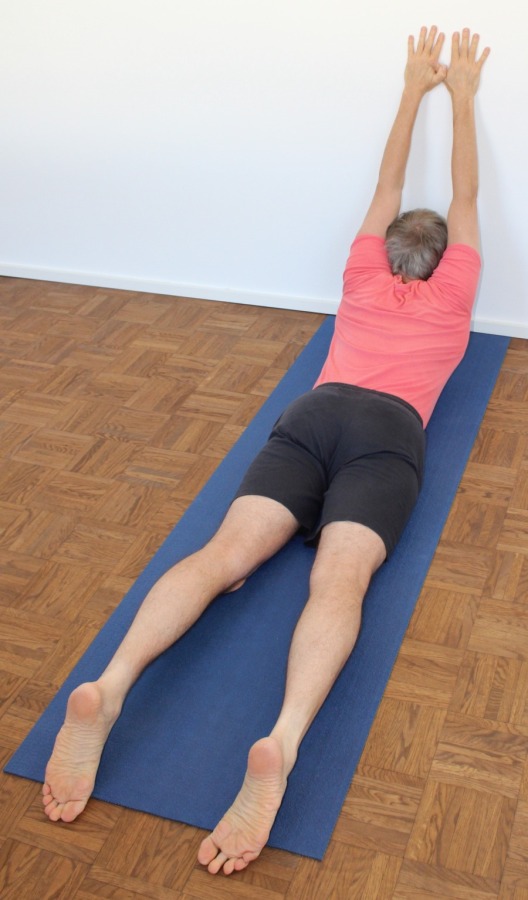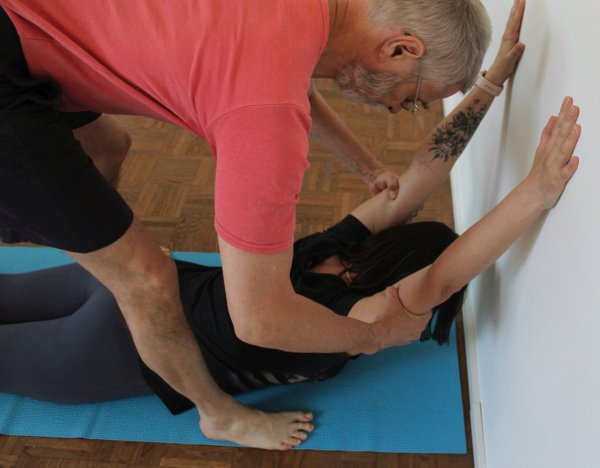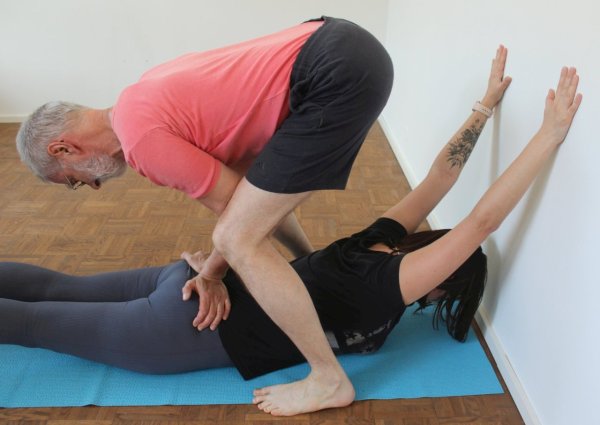Contents
„hyperbola“

 instructions and details with working links as PDF for download/print
instructions and details with working links as PDF for download/print
Detailfotos
Measure the distance to the wall |
Feedback: We would love to hear what you think about this description, give us feedback at:
postmeister@yogabook.org
last update: 30.12.2018
Trivia name: hyperbola
Level: A
- Classification: A
- Contraindication
- Effects of
- Preparation
- follow-up
- derived asanas
- similar asanas
- diagnostics
- Instruction
- details
- Variants
Classification
classic: shoulder stretch
Contraindication
In the case of facet syndrome, spondylolisthesis (spondylolisthesis) and spinal canal stenosis, this pose can easily lead to the reoccurrence of the respective complaints. The more restricted the flexibility of the hip flexors and shoulder joints is in the direction of frontal abduction, the more this applies.
Effects
- (231) Shoulder joint: stretching towards frontal abduction
- (501) Stretching the latissimus dorsi
Preparation
The only task of the pose is a passive but intensive frontal abduction in the shoulder joint, prepare with:
- Downface dog, especially the „wide“ variation as a general stretch of the shoulder
- Back extension, especially the „elevated“ variation as a general stretch of the shoulder
- Rectangular handstand as a synergistic pose for the shoulders and thoracic spine
- Handstand as a related and synergistic pose
- Elbow stand as a related and synergistic pose with further external rotation of the arms.
- Rectangular elbowstand as a related and synergistic pose with further external rotation of the arms
- Dog elbow pose as a related and synergistic pose with further external rotation of the arms
- Hyperbola as one of the most effective and efficient stretches in the direction of frontal abduction without external rotation of the arms
- Shoulder opening on the chair as one of the most effective and efficient stretches in the direction of frontal abduction with external rotation of the arms
Follow-up
Just as this pose can be used to prepare the lower back, it should also help if the pose has caused tension in the lower back:
- parsva uttanasana
- virasana forward bend (child’s pose)
- parsva upavista konasana
- parivrtta trikonasana
- parsvottanasana
- half lotus forward bend
- karnapidasana
Derived asanas:
Similar asanas:
Diagnostics (No.)
The flexibility of the shoulder can be recognised very well here, including side discrepancies, and there may be indications of disorders of the shoulder:
- Irritable hypertonus of the deltoid: ambitious beginners in yoga in particular tend to develop irritation in the deltoid, which is localised in the area of the muscle origins, presumably due to overstraining of the structures through frequent repetitive demands in full frontal abduction and is also noticeable under such stress, see FAQ.
- Various pathological changes of the shoulder joint such as impingement syndrome, frozen shoulder, calcifications of the long biceps tendon, which cannot all be discussed here and require clarification.
- Side discrepancies in flexibility: one shoulder will then be higher or the arm will bend more
The flexibility in the shoulder joint is recognisable in the form of the degree of deviation in the three dimensions of movement:
- Outward deviation of the upper arms with (as the hands are fixed) consecutive flexion of the elbow joints
- Loss of external rotation of the arms
- Incorrect angle of frontal abduction that does not reach 180° or not permanently
(650) Kyphosis and lordosis of the spine:
The deviations from the physiological double-S shape and the physiological behaviour during movement are sometimes clearly visible here. Normally, the entire back should curve relatively evenly in this case. If the thoracic spine remains convex or straight, this indicates a limited ability to extend. If the lumbar spine is visibly hyperkyphotic (too concave), we must assume a pronounced hollow back with a clear tendency to discomfort in the lumbar spine area or even see a „hip triangle“ as in hip flexor flexibility test. See the FAQ.
(611) Pelvic obliquity/unequal shoulder height/scoliosis of the spine:
The lateral deviations of the spine from the sagittal plane known as scoliosis are also quite visible in this pose. See the FAQ.
Variants:
(S) push butts away from the back
Instructions
- Lie in prone position facing the wall on the floor with your head no more than 10 cm from the wall.
- Raise one arm forwards and upwards so that you can position the corresponding hand as high up on the wall as possible while turning your torso slightly to the side. Crawl your fingers higher again, as far as possible.
- Then place the whole palm of your hand on the wall, facing upwards.
- Spread your fingers to make it easier to press your hand evenly onto the wall.
- Place the second hand on the wall in the same way, so that both hands are as high as uniformly possible next to each other.
- Interlace the two thumbs so that the hands secure each other a little against slipping.
- Extend your arms fully, turn them out as far as possible and release your upper body from the shoulders downwards and backwards (elevation of the shoulder blades).
- Relax the back, buttocks and leg muscles as much as possible to maximise the effect of the weight of the upper body and head on the muscles of the shoulder joints.
Details
- Press the inside of the hand onto the wall, but avoid turning the arms in, which is the wrong direction, as a result. Advanced users can also press the outer edges of the hands onto the wall instead, with the hands resting on top of each other and the thumbs interlocked. This improves the external rotation of the arms and further intensifies the stretch, while at the same time reducing the feeling of tension in the trapezius.
- Keep your hands as high as possible on the wall, the gravity of the upper body and head will then work in favour of stretching the arms as much as possible.
- If the flexibility of the shoulder joint is quite restricted, the arms will almost inevitably tend to bend at the elbow joints. One of the major challenges of this pose is noticing this and constantly trying to prevent it. The reduced flexibility in the shoulder joints forces a deviation from the exact extension, which usually occurs in three parameters due to the three-dimensional flexibility of the shoulder joint:
- Failure to achieve an extension angle of 180° frontal abduction in the shoulder joints
- lateral adduction of the upper arm in combination with corresponding flexion of the elbow joint. This adduction can be recognised by the non-extended angle in the elbow joint as well as the lack of parallelism between the forearm and the corresponding upper arm. In clear cases, the upper arms even diverge instead of converging like the forearms (after all, the hands are next to each other).
- A reduced external rotation or tendency to internal rotation of the upper arm in the shoulder joint. In combination with the first and second evasive movements, this often results in an outward and upward movement of the elbow instead of the required downward and inward movement.
- Relaxation of the muscles in the back, buttocks and back of the leg is an important detail of the pose, as otherwise the moments acting in the shoulder joints can be reduced to almost zero. However, in many cases it is not possible for performers to completely relax these muscle groups due to the great effectiveness of the pose. In some cases, disturbances in the well-being of the lower back are also recorded, which, if not tolerable, can be limited by a certain, moderate use of the glutes in particular to improve the extension in the hips and to defuse the angles in the vertebral joints of the lumbar spine. If this measure causes the effect in the shoulder area to be largely lost, preparing the muscles in the lumbar spine area (uttanasana, parsvottanasana, karnapidasana, etc.) or appropriate follow-up work can also be helpful.
- The feet should lie heavily on the floor as a sign of relaxation of the muscles on the back of the legs. If, on the other hand, they are light or raised, this indicates tension in the muscles in question. If you have difficulty consciously relaxing this muscle area, you may be advised to press your feet to the floor.
- If cramps occur in the soles of the feet, the position of the thighs can be changed in terms of rotation, as can the position of the feet. The feet can also be positioned so that the bottom of the toes are on the floor.
- The shoulder muscles (deltoids) can become cramp-like. Previously performed stretching poses such as gomukhasana and, as far as possible, actively or passively increasing the external rotation of the arms can help to counteract this.
- Masking effects can often be observed in this pose. While the area of the shoulder muscles (usually the pars clavicularis of the deltoid) is the first to feel crampy, weakness in the lower back is often felt afterwards. If the pose is held for a longer period of time, especially in more flexible people, the stretching of some parts of the lateral back muscles such as the latissimus dorsi or the teres major can be felt, as this is an important internally rotating adductor muscle of the shoulder joint and is more strongly affected due to the external rotation performed.
- To counteract the tendency to cramp in the sole of the foot when the ankle is extended, the feet can also be placed upright, whereby care should also be taken here to ensure that there is as little tension as possible in the muscles of the back of the leg, which would be suitable for holding the back up.
- In this pose, the head is held in extension of the spine. However, if a certain amount of stretching of the neck muscles is desired or comfortable, the head can also be held more or less towards the chest.
- In some cases, the pressure of the kneecap on the floor is perceived as uncomfortable. In this case, the legs can be turned out slightly, which does not significantly affect the rest of the pose.
- If the pressure of the pubic bones or lower ribs on the floor is uncomfortable, use a blanket underneath.
Variants
(S) Turn the arms out

This variation increases the stretch, but can also reduce the tendency of the shoulder muscles to cramp
Instructions
- As the supporter, stand with both legs symmetrically over the back of the performer and with the feet to the side of the upper body.
- Grasp the centre of the upper arms with both hands and turn them out so that the biceps rotate more upwards. Make sure that the arms remain stretched or help to stretch the arms by pushing both upper arms towards each other.
Details
- The hyperbola is a highly effective pose for promoting frontal abduction in the shoulder joints, in which corresponding evasive movements naturally occur if they are not prevented by the performer, a prop or, as in this variation, a supporter. These are the reduction of the external rotation of the upper arms in the shoulder joints and the occurrence of lateral adduction of the arms. Both can be prevented relatively easily by the supporter, albeit sometimes only with a certain amount of force, by pushing the arms towards each other and turning them out further, i.e. turning the biceps towards the ceiling
(P) Po vom Rücken weg drücken

Instructions
- Take the pose described above.
- The supporter pushes the buttocks away from the back with both hands
Details
- This support counteracts the unpleasant sensation in the lower back that sometimes occurs in this posture and the lumbar spine is less hyperlordosed with this support.
- The pressure is applied just before the highest point of the upwardly curving glutes and mainly with the carpus. If it were to be applied exactly on top of it or caudal to it, there would be a risk of the supporter slipping with the hands. Pressure well in front (cranial) of the highest point, on the other hand, can lead to uncomfortable angles in the wrist.
